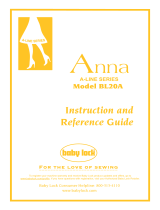3
For European version
1. KNOWING YOUR SEWING MACHINE
Machine identication ------------------------------------------------6 - 7
Accessories
-------------------------------------------------------------8 - 9
Setting up your machine -----------------------------------------10 - 11
Spool pins, Presser foot lifter ---------------------------------- 12 - 13
Feed dogs control ------------------------------------------------- 12 - 13
Converting to free-arm sewing -------------------------------- 14 - 15
Winding the bobbin ----------------------------------------------- 16 - 17
Threading the bobbin thread ----------------------------------- 18 - 19
Threading the top thread ---------------------------------------- 20 - 23
Using automatic needle threader
Needle, thread and fabric chart ------------------------------- 24 - 25
Adjusting top thread tension ----------------------------------- 26 - 27
Changing presser foot ------------------------------------------- 26 - 27
Control panel function ------------------------------------------- 28 - 33
Reverse operation switch --------------------------------------- 34 - 35
2. STARTING TO SEW
Quick reference table of stitch length and width ---------- 36 - 39
Straight stitching -------------------------------------------------- 40 - 43
Keeping seams straight, Inserting zippers and piping
Hand-look quilt stitch --------------------------------------------- 42 - 43
Straight stitch with auto tie-off function ---------------------- 42 - 43
Zigzag stitching ---------------------------------------------------- 44 - 45
Adjusting stitch width and length, Satin stitch
Placement of patterns
TABLE OF CONTENTS
Blindhem stitch ---------------------------------------------------- 46 - 47
Multi-stitch zigzag, Shell stitch --------------------------------- 48 - 49
Stretch stitches ---------------------------------------------------- 50 - 59
Straight stretch stitch, Overedge stitch, Feather stitch,
Ric-rac stitch, Pin stitch,
Blanket stitch, Honeycomb stitch,
Entredeux stitch, Ladder
stitch,
Double overlock stitch,
Criss-cross stitch, Crossed stitch, Slant overedge stitch,
Slant pin stitch,
Greek key stitch, Fishbone stitch,
Thorn stitch, Reinforced overedge stitch
Decorative designs ----------------------------------------------- 60 - 61
Ideas on design stitching
Continuous patterns ---------------------------------------------- 62 - 63
Novelty patterns --------------------------------------------------- 64 - 65
Sewing on a button ----------------------------------------------- 64 - 65
Buttonhole making ------------------------------------------------ 66 - 71
Automatic buttonhole, Corded buttonholes,
Manual buttonhole
3. CARING FOR YOUR MACHINE
Cleaning hook area and feed dogs --------------------------- 72 - 73
4. OTHER INFORMATION
Satin stitch foot, Twin needle ----------------------------------- 74 - 75
Straight stitch needle position --------------------------------- 76 - 77
5.
PERFORMANCE CHECKLIST
----------------------- 78 - 79
Dimensions: 438 mm × 203 mm × 310 mm
Mass of the equipment: 7.3 kg
Rated Voltage: 230V ~
Rated Frequency: 50Hz
Rated input: 65W
Rated ambient temperature: 15 - 35°C
Acoustic noise level: less than 70db(A)




















